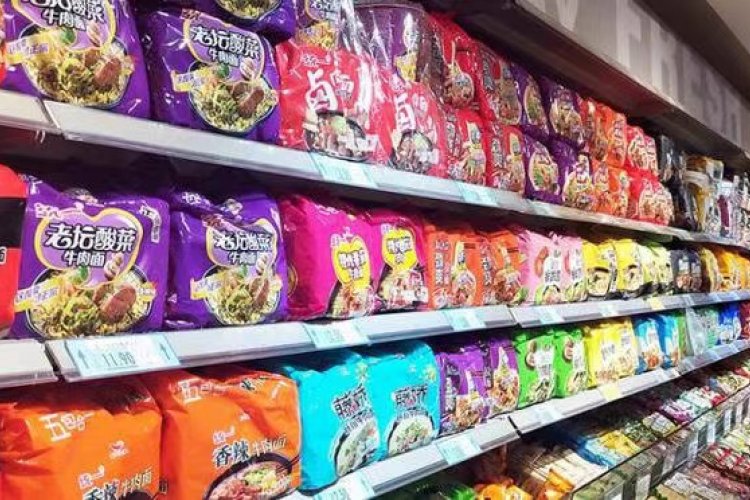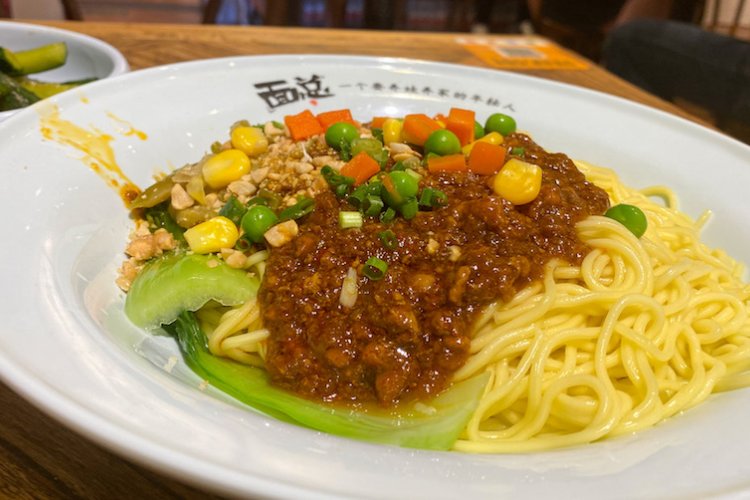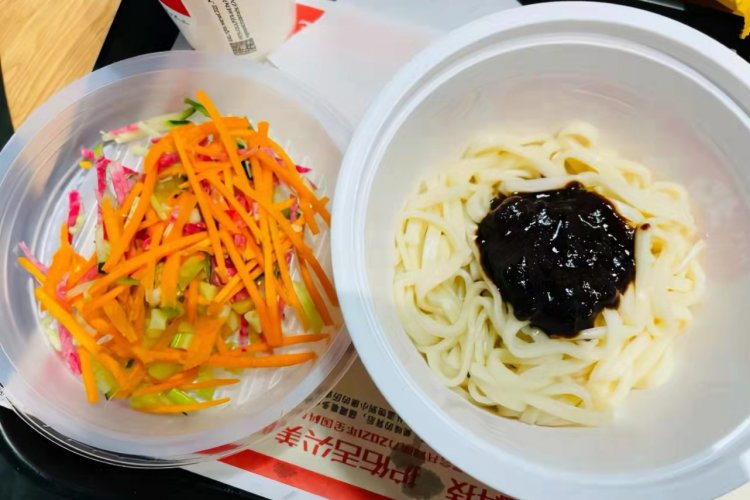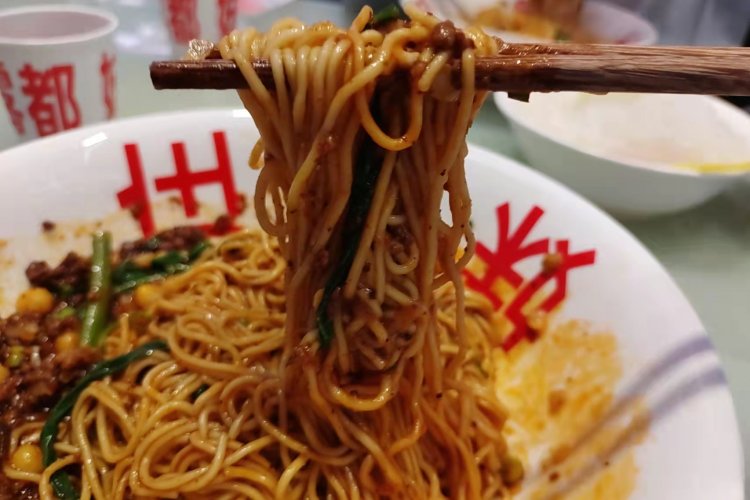Not-So-Skinny-Dipping: Pop-Up Ramen
This is the first of several reports about Wangjing’s Ramen Pavilion.
Tsujita is a famous ramen brand with four branches in Tokyo – and now, a pop-up stall here in Beijing. The most important thing to know about Tsujita is their specialty: dipping (tsukemen) ramen. It’s not a soup noodle in the conventional sense. Instead, you get a bowl of thick noodles (boiled, drained, rinsed, cooled) and a smaller bowl of sauce to dip them into.
So, are you ready to upend your basic concept of ramen? If so, head to Wangjing International Shopping Center, find the Ramen Pavilion, plunk down some cash for the pre-paid card (RMB 100 minimum value; RMB 5 deposit), and look for Tsujita (the first stall on your right if you’re approaching from the Ito-Yokado side; the last stall on your left if you approach via the stage).
We ordered the signature dipping ramen (zhanmian 蘸面; RMB 55), and they brought out two bowls. The bigger bowl was a simple poem: Noodles, laver, lime.
In the smaller bowl, a generous ladling of savory stew hid a soft-boiled egg and several slices of braised pork (chashao 叉烧). It was oily and rich – all the better to coat the ropy yellow ramen.
Tsukemen separates the ramen experience into its elemental constituents – noodle and flavoring – in order that you may combine them at your pleasure. This heady power may cause you to feel like a puppetmaster, manipulating the strings that dangle from your cross-sticks. (“Dance, my plump little noodles, dance!”)
Then everything dissolves into a haze of plunging and swishing and slurping and chewing, and too late, you realize that the silly figure dancing at the end of the noodle strands is you.
Perhaps most commendable about Tsujita’s ramen is its delightful texture. Those who like maximum toothiness will appreciate how unrelenting these noodles are. The masterminds behind tsukemen ramen must value this as well; the dipping method ensures that your ramen stays springy and chewy until the last strand is dunked and devoured.
Each bowl of classic tsukemen is served with a chunky slice of sudachi lime. We squeezed it on the noodles halfway through and found it added brightness and contrast to the rich dipping broth. In fact, we might have liked a more generous offering of the sudachi; we enjoyed the dimension it added, but found its effects diluted by the sheer volume of noodles.
We also tried a spicy version (RMB 50) of the dipping ramen. It has a pleasantly zingy heat but no soft-boiled egg.
Lastly, we ordered a bowl of the pork bone ramen (RMB 55), a more typical soup noodle. It arrived at the table sporting a half-centimeter-thick oily cap, with bits of pork fat happily suspended above the thick broth. It would seem its primary reason for existing is to do away with the stereotype that all Japanese fare is light and healthy.
The broth was exceedingly rich, its accompanying meat aggressively seasoned and full of flavor. The chunky cuts of pork appeared drier than we might have liked, but were strangely tender nonetheless. Worth a try, but we don’t suggest eating a whole bowl yourself.
Final notes: Tsujita’s gyoza are clearly an afterthought. Soggy, as if they took freshly boiled dumplings and threw them onto a skillet. A shame. Scold yourself for letting your thoughts stray from ramen for even a single second, and move on to the next stall.
In our quest for ramen knowledge, we also stumbled upon this handy graph (above). The horizontal axis measures "taste" (weidao 味道) and runs from light (left) to salty (right). The vertical axis measures "soup base" (tangdi 汤底) and runs from clear (bottom) to thick (top). You'll find Tsujita's dipping ramen occupying the very top right corner, meaning it is the saltiest of the options and features the thickest broth. Who knew learning the Cartesian coordinate plane would actually be useful someday?
Ramen Pavilion. Wangjing International Shopping Center, 9 Wangjing Jie, Chaoyang District (no tel). Daily 11am-10pm (until mid-December 2011) 朝阳区望京街9号望京国际商业中心
Photos by Marilyn Mai, image from Sina.com blog user midori
Related stories :
Comments
New comments are displayed first.Comments
![]() maxwu
Submitted by Guest on Fri, 11/04/2011 - 10:22 Permalink
maxwu
Submitted by Guest on Fri, 11/04/2011 - 10:22 Permalink
Re: how do i get there?
I went tonight, it was unbelievably amazing!!!
Line 10 Sanyuanqiao station. C1 exit
walk 100 meters to bus stop(follow pedestrians, you know where the bus stop is, if not, cross a 2-meter wide road which is a one-way down from the bridge, you can't really cross to the other side anyways) take 916 bus,2 stops,
get off at 大山桥东站 (Dashanqiao Dong Zhan)
Walk towards 望京国际商业中心(Wangjing International business center which are 8 bold letter, red at night, on top of the building facing you when you get off the bus) for 450 meters or less
***I seriously suggest take taxi from the subway station, only 12kuai, 15 when it's busy I assume. Not worth the trouble unless you really feel like taking buses.
The Japanese Ramen street should be quite noticeable once you get there.and check the tiny map on the official site to find the exact location.
If you are off the bus but don't see any bold letters, you should cross the street that you just came from to the other side, now that you've walked across the street towards the center, you should be on the left side, there's a bank branch there, the first thing you see, and keep walking, until you see an opening on the wall, a square-like space inside with a merry-go-round. Alas, the street is behind it, now you see the Japanese characters, and you are prepared to buy cards which can only be purchased 100 kuai every time...I'm sure you need to put more than 100 in, it's delicious!!!!!!
http://ribenlamian.com/chinese/index.html# is the official site. There's a tiny map there without much direction though.
Hope this is helpful if you still want to go...
Thx
![]() andrewchack
Submitted by Guest on Mon, 09/12/2011 - 21:12 Permalink
andrewchack
Submitted by Guest on Mon, 09/12/2011 - 21:12 Permalink
how do i get there?
how do I get there with the subway?
![]() martback
Submitted by Guest on Wed, 09/07/2011 - 14:48 Permalink
martback
Submitted by Guest on Wed, 09/07/2011 - 14:48 Permalink
Re: Not-So-Skinny-Dipping: Pop-Up Ramen
Closed until September 12.
Validate your mobile phone number to post comments.






